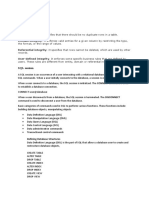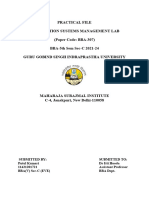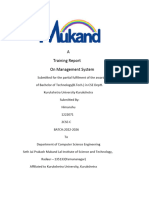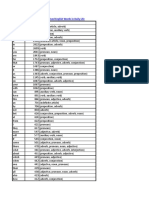0 ratings0% found this document useful (0 votes)
6 viewsSQL-Server-Online-Training
PDF sql
Uploaded by
Pravallika ArraCopyright
© © All Rights Reserved
Available Formats
Download as PDF, TXT or read online on Scribd
0 ratings0% found this document useful (0 votes)
6 viewsSQL-Server-Online-Training
PDF sql
Uploaded by
Pravallika ArraCopyright
© © All Rights Reserved
Available Formats
Download as PDF, TXT or read online on Scribd
You are on page 1/ 2
An ISO 9001 : 2015 Certified Company
Opp. Satyam Theatre, Durga Bhavani Plaza, Ameerpet, Hyd-16
Introduction To DBMS History and Features of TSQL
File Management System And Its Drawbacks Types Of TSQL Commands
Database Management System (DBMS) and Data o Data Definition Language (DDL)
Models o Data Manipulation Language (DML)
o Physical Data Models o Data Query Language (DQL)
o Logical Data Models o Data Control Language (DCL)
Hierarchical Data Model o Transaction Control Language (TCL)
(HDBMS) o Database
Network Data Model (NDBMS) Creating Database
Relational Data Model (RDBMS) Altering Database
Object Data Model (ODBMS) Deleting Database
Object Relational Data Model Data Types In TSQL
(ORDBMS) Data Definition Language (DDL)
Conceptual Data Models Create
o Entity – Relationship (E-R) Model Alter
Introduction To SQL Server Drop
Advantages and Drawbacks Of SQL Server Truncate
Compared To Oracle And DB2 Data Manipulation Language (DML)
o Connecting To Server Insert, Update & Delete
Server Type Differences Between Delete and Truncate
Server Name MERGE command
Authentication Modes
Sql Server Data Query Language (DQL)
Authentication Mode Select
Windows Authentication Where clause
Mode Predicates
Login and Password o Between
Sql Server Management o In
Studio and Tools In o Like
Management Studio
Order By Clause
Object Explorer
Distinct Clause
Object Explorer
Details Column aliases
Query Editor Computed columns
TSQL (Transact-Structured Query Language) Built In Functions
Introduction To TSQL o Numeric Functions
o Character Functions Identity
o Conversion Functions Generating sequence numbers using identity with
o Date Functions SEED, INCR
o Special functions
o Aggregate Functions
o Ranking Functions Sequences
Set Operators creating, altering, dropping sequence
Union
TSQL Programming
Intersect
Drawbacks Of TSQL that leads to TSQL
Except Programming
Joins
Introduction To TSQL Programming
Inner Join or Equi Join
Control statements In TSQL Programming
Outer Join o Conditional Control Statements
o Left Outer Join If
o Right Outer Join
o Full Outer Join Looping Control Statements
Non-Equi Join o While
Cursors
Self Join Working With Cursors
Cross Join Types Of Cursors
ANSI joins o Forward Only and Scrollable Cursors
Sub Queries o Static, Dynamic and Keyset Cursors
o Single Row Sub Queries o Local and Global Cursor
o Multi Row Sub Queries Exception Handling
o Any or Some o Implementing Exception Handling
o ALL
o Adding and removing User Defined Error
o Co-Related Sub Queries
Messages To And From SQL Server Error
Exists and Not Exists Operators
Messages List
o Derived Tables & CTEs
o User defined exceptions
o Scalar Subqueries
Stored Sub Programs
Transaction Management
Advantages Of Stored Sub Programs compared to
Introduction Independent SQL Statements
Begin Transaction Stored Procedures
Commit / Rollback Transaction o Creating , Altering and Dropping
Save Transaction o Input and Output Parameters
Role Of Log File In Transaction Management o Permissions on Stored Procedures
Implicit Transactions User Defined Functions
Security o Creating, Altering and Dropping
SQL Server Authenticated Login o Types Of User Defined Functions
Windows Authenticated Login Scalar Functions
Login Creation Table Valued Functions
Inline Table Valued
User Creation Functions
Granting Permissions Multi Statement Table
Revoking Permissions Valued Functions
Roles o Permissions On User Defined Functions
Triggers
Views o Purpose of Triggers
Purpose Of Views o Differences Between Stored Procedures
Simple and Complex Views and User Defined Functions and Triggers
o Creating, Altering and Dropping Triggers
Encryption and Schema Binding Options in creating
o Magic Tables
views
Indexes
o Instead Of Triggers
Working With XML Data Type
Non Clustered Index
Backup and Restore Of Database
Unique Index
Exporting & Importing Data
Clustered Index
Attach and Detach of Database
Normalization
You might also like
- Daniel 2 and 7 - Equal or Not Equal - Charles Cooper100% (1)Daniel 2 and 7 - Equal or Not Equal - Charles Cooper22 pages
- SQL and TSQL Chek List ........ Which Would Help To Prepare AccordinglyNo ratings yetSQL and TSQL Chek List ........ Which Would Help To Prepare Accordingly6 pages
- Basic Structured Query Language (Repaired)No ratings yetBasic Structured Query Language (Repaired)28 pages
- LABE MANUALOF DISTRIBUTED DATABASE SYSTEMNo ratings yetLABE MANUALOF DISTRIBUTED DATABASE SYSTEM20 pages
- Oracle SQL & PL/SQL Training: Click To Edit Master Subtitle StyleNo ratings yetOracle SQL & PL/SQL Training: Click To Edit Master Subtitle Style99 pages
- Database Management Systems Syllabus e8f0ed40 Ddbb 467d Ab10 d3d4e8995ca1No ratings yetDatabase Management Systems Syllabus e8f0ed40 Ddbb 467d Ab10 d3d4e8995ca18 pages
- CC6 Reviewer Chap.5-7: Structured Query Language (SQL)No ratings yetCC6 Reviewer Chap.5-7: Structured Query Language (SQL)8 pages
- Theory of Database - Oracle Programming NciiiNo ratings yetTheory of Database - Oracle Programming Nciii108 pages
- CS8481 - Database Management Systems Laboratory: Student Lab ManualNo ratings yetCS8481 - Database Management Systems Laboratory: Student Lab Manual60 pages
- Paper 77-Feature Selection for Phishing Website (1)No ratings yetPaper 77-Feature Selection for Phishing Website (1)9 pages
- 2020 Latest Braindump2go DP-900 PDF Dumps and DP-900 VCE Dumps(23-33)No ratings yet2020 Latest Braindump2go DP-900 PDF Dumps and DP-900 VCE Dumps(23-33)4 pages
- 2020 Latest Braindump2go DP-900 PDF Dumps and DP-900 VCE Dumps(34-44)No ratings yet2020 Latest Braindump2go DP-900 PDF Dumps and DP-900 VCE Dumps(34-44)5 pages
- Speak Your Mind Scope and Sequence Level Starter CompressedNo ratings yetSpeak Your Mind Scope and Sequence Level Starter Compressed2 pages
- Write Affirmative Sentences in The Correct Word OrderNo ratings yetWrite Affirmative Sentences in The Correct Word Order2 pages
- QA Master - 4840647 - 2024 - 03 - 27 - 12 - 07No ratings yetQA Master - 4840647 - 2024 - 03 - 27 - 12 - 07118 pages
- The Pearl 14th Century English Poem Giovanni Boccaccio 1313-1375 Sir Israel Gollancz 1921No ratings yetThe Pearl 14th Century English Poem Giovanni Boccaccio 1313-1375 Sir Israel Gollancz 1921362 pages
- Instructions for Matsutec AIS HA-102 ConfigNo ratings yetInstructions for Matsutec AIS HA-102 Config9 pages
- Software Mining Repository Notes Unit 1No ratings yetSoftware Mining Repository Notes Unit 110 pages
- Sybase IQ Installation and ConfigurationNo ratings yetSybase IQ Installation and Configuration112 pages
- Powerbuilder Enterprise: Installation GuideNo ratings yetPowerbuilder Enterprise: Installation Guide42 pages
- 90 + 100 + 5 - 7. 5 Tens, 3 Hundreds, 8 Ones - 8. 400 + 1000 + 20 + 8 - 9. 5 Hundreds, 6 Tens, 9 Ones - 10. 1 Hundred, 1 Thousands, 3 OnesNo ratings yet90 + 100 + 5 - 7. 5 Tens, 3 Hundreds, 8 Ones - 8. 400 + 1000 + 20 + 8 - 9. 5 Hundreds, 6 Tens, 9 Ones - 10. 1 Hundred, 1 Thousands, 3 Ones2 pages
- Smart Integration Connector Guide 1 (1)No ratings yetSmart Integration Connector Guide 1 (1)117 pages



































































































